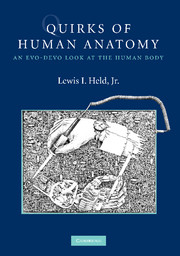Book contents
- Frontmatter
- Contents
- Preface
- CHAPTER 1 BACKGROUND
- CHAPTER 2 SYMMETRY AND ASYMMETRY
- CHAPTER 3 MYSTERIES OF THE MIDLINE
- CHAPTER 4 MERISM AND MODULARITY
- CHAPTER 5 SEXUAL DIMORPHISMS
- CHAPTER 6 SILLY, STUPID, AND DANGEROUS QUIRKS
- CHAPTER 7 MIND AND BRAIN
- EPILOGUE
- APPENDIX: QUIRKS OF HUMAN BEHAVIOR
- References
- Index
CHAPTER 3 - MYSTERIES OF THE MIDLINE
Published online by Cambridge University Press: 05 August 2012
- Frontmatter
- Contents
- Preface
- CHAPTER 1 BACKGROUND
- CHAPTER 2 SYMMETRY AND ASYMMETRY
- CHAPTER 3 MYSTERIES OF THE MIDLINE
- CHAPTER 4 MERISM AND MODULARITY
- CHAPTER 5 SEXUAL DIMORPHISMS
- CHAPTER 6 SILLY, STUPID, AND DANGEROUS QUIRKS
- CHAPTER 7 MIND AND BRAIN
- EPILOGUE
- APPENDIX: QUIRKS OF HUMAN BEHAVIOR
- References
- Index
Summary
If you move one arm, the other does not automatically follow suit. In contrast, our eyes are yoked together whenever we shift our gaze [767, 1562]. Eye coordination makes sense because seeing objects from two points of view lets us compute distances based on parallax (Fig. 3.1) [1215, 2065, 2783]. Depth perception was critical for our primate ancestors, who cavorted from branch to branch high in the jungle canopy [1354, 2515]. The fact that our eyes blink in sync, however, makes no sense because it makes us blind, albeit for only an instant [2824].
Our lenses refract photons from each point in visual space onto the “nasal” half of one retina (near the nose) and the “temporal” half of the other (near the temple). For us to compare the images from our left and right eyes, nasal axons cross the midline and join temporal axons from the other eye before being bundled and sent to higher centers for stereoscopic analysis [59, 503]. It is astounding that we do not perceive even the slightest hint of a seam where our visual field is constantly being split right down the middle [647].
Why do optic nerves cross the midline?
Retinal axons cross at a juncture called the “chiasm,” which is named for the X shape of the Greek letter chi [728, 2061]. Rare mutations have been found in humans that obliterate crossing completely [1150, 2266], and, as expected, the affected individuals have negligible depth perception [289].
A more common type of miswiring is seen in albinos [1027]. Their depth perception is impaired [1507] because of excessive (>50%) crossing of axons at the chiasm [1282, 2306].
- Type
- Chapter
- Information
- Quirks of Human AnatomyAn Evo-Devo Look at the Human Body, pp. 33 - 48Publisher: Cambridge University PressPrint publication year: 2009



